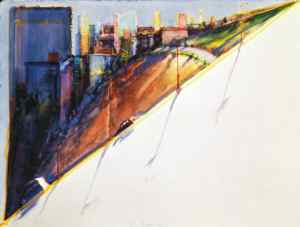He's got a retrospective on now at the San Jose Museum of Art, and this exhibit is making it's way around the country. If you get a chance to catch it when it comes to your town, RUN, don't walk, to go see it!
image source
So temptingly tactile, there was a sign up in the museum imploring viewers to keep their paws off the works. His skill with layering colors, one on top of another, and juxtaposing them to create form and definition... well, it's just mind-boggling.
image source
image source
image source
Here's a great example of his use of vibrating colors, which accentuate one another, creating an almost shimmery effect. (the magnifying glass is not part of the painting) you don't see if from far away, only when you get up really closeimage source
image source
image source
A little close up of one of his cityscapes from San Francisco. Notice how ribbons of color run throughout the images... And what glorious shadows- bright blues, violets, turquoises... they are as luminescent as the sections flooded in sunlight. image source
Ah, his color palettes make me swoon.
image source
"Thiebaud says “ I work with my students to understand that there are two ways of rendering light. Halation is a pretty simple trait. (Halation refers to the aura, halo, or hazy color around the edge of a subject; or vibrations of two colors next to each other.)Test is yourself sometime. Take a strong light, or even better, go outside. Put the light fairly close to an object and stare until the two views begin to oscillate. They begin to vibrate because the eye will hold its position for a long time. But, because you are seeing two images, stereoscopically, they are never quite perfectly fused. That is how you get halos, or auras.”(source)image source
image source
image source
image source
Searching for the perfect baby gift? I'd be delighted to receive anything by Wayne Thiebaud! (Ah, sometimes I crack myself up, seeing as how his work is hanging in most of the major museums in the country...)














